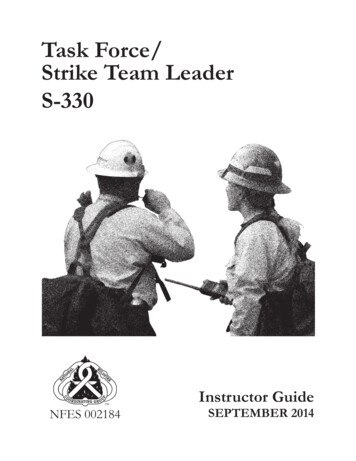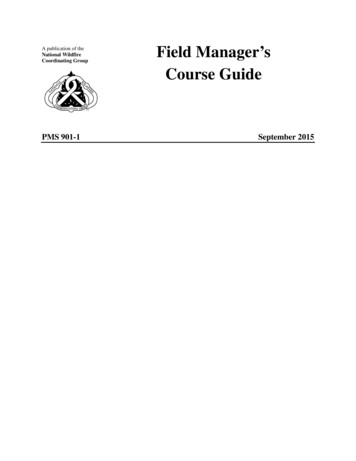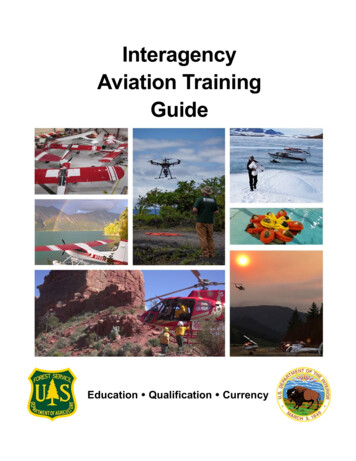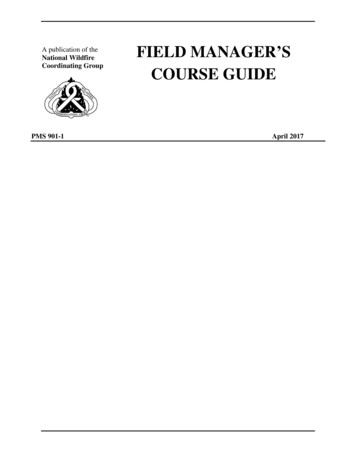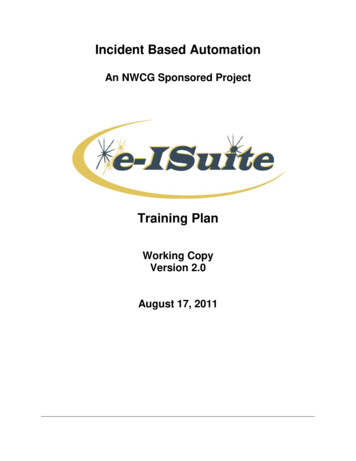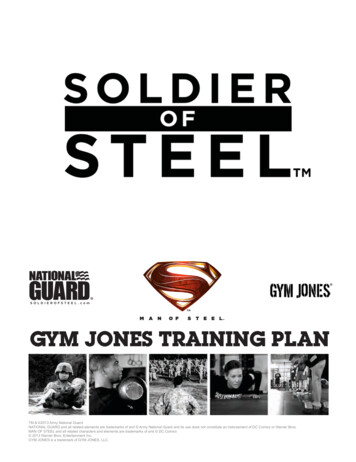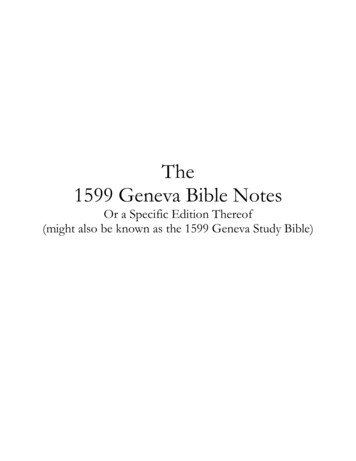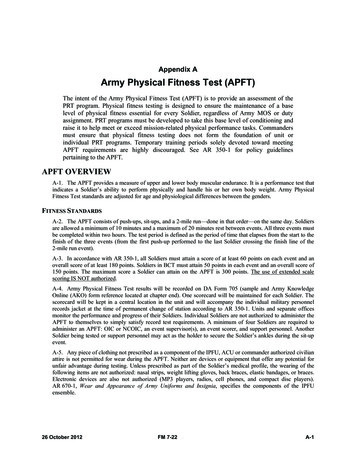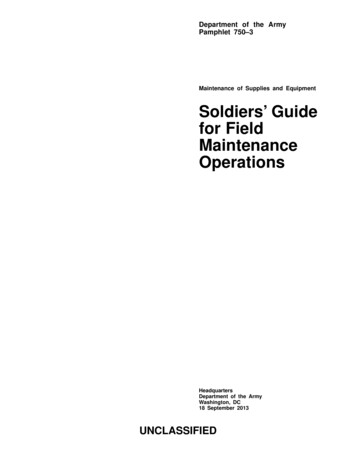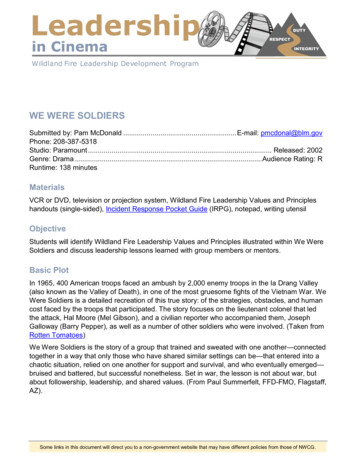
Transcription
Facilitator ReferenceWE WERE SOLDIERSSubmitted by: Pam McDonald . E-mail: pmcdonal@blm.govPhone: 208-387-5318Studio: Paramount . Released: 2002Genre: Drama . Audience Rating: RRuntime: 138 minutesMaterialsVCR or DVD, television or projection system, Wildland Fire Leadership Values and Principleshandouts (single-sided), Incident Response Pocket Guide (IRPG), notepad, writing utensilObjectiveStudents will identify Wildland Fire Leadership Values and Principles illustrated within We WereSoldiers and discuss leadership lessons learned with group members or mentors.Basic PlotIn 1965, 400 American troops faced an ambush by 2,000 enemy troops in the Ia Drang Valley(also known as the Valley of Death), in one of the most gruesome fights of the Vietnam War. WeWere Soldiers is a detailed recreation of this true story: of the strategies, obstacles, and humancost faced by the troops that participated. The story focuses on the lieutenant colonel that ledthe attack, Hal Moore (Mel Gibson), and a civilian reporter who accompanied them, JosephGalloway (Barry Pepper), as well as a number of other soldiers who were involved. (Taken fromRotten Tomatoes)We Were Soldiers is the story of a group that trained and sweated with one another—connectedtogether in a way that only those who have shared similar settings can be—that entered into achaotic situation, relied on one another for support and survival, and who eventually emerged—bruised and battered, but successful nonetheless. Set in war, the lesson is not about war, butabout followership, leadership, and shared values. (From Paul Summerfelt, FFD-FMO, Flagstaff,AZ).Some links in this document will direct you to a non-government website that may have different policies from those of NWCG.
Facilitator ReferenceCast of Main CharactersMel Gibson . Lt. Col. Hal MooreMadeleine Stowe . Julie MooreGreg Kinnear . Maj. Bruce 'Snake' CrandallSam Elliott . Sgt. Maj. Basil PlumleyChris Klein .2nd Lt. Jack GeogheganKeri Russell . Barbara GeogheganBarry Pepper . Joe GallowayDon Duong . Lt. Col. Nguyen Huu AnRyan Hurst . Sgt. Ernie SavageFacilitation OptionsWe Were Soldiers illustrates an abundance of leadership values and principles. Students shouldhave few problems identifying those that correspond to the Wildland Fire Leadership Values andPrinciples. The objective is not to identify every leadership principle but to promote thought anddiscussion. Students should be less concerned with how many principles they view within thefilm and more concerned with how the principles they do recognize can be used to developthemselves as a leader.Obtain copies of the Crew Cohesion Assessment Tool, developed by Mission-CenteredSolutions, from Toolbox on the Wildland Fire Leadership Development website for use withGuided Discussion, #9. If you have not used this tool, this might be an excellent opportunity todo so.Reference tools are available on the official movie and Lt. General Moore’s and Galloway’s Websites (see links below). References include maps, battle overviews, actual After Action Review,and other historical items.We Were Soldiers Once .And Young: IA Drang—the Battle That Changed the War in Vietnam(Moore and Galloway) is a selection in the Professional Reading Program in the Toolbox on theWildland Fire Leadership Development website.The film can be viewed in its entirety or by clip selection, depending on facilitator intent and timeschedules. Another method is to have the employee(s) view the film on his/her own and thenhold the discussion session.WFLDP Leadership in Cinema – We Were Soldiers2 of 10
Facilitator ReferenceFull-film Facilitation Suggestion:When opting for the full-film method, the facilitator should determine a good breaking point nearthe middle of the film.1. Review the Wildland Fire Leadership Values and Principles with students.2. Advise students to document instances within the film that illustrate/violate the WildlandFire Leadership Values and Principles on the handout provided.3. Break students into small discussion groups.4. Show students We Were Soldiers.5. Break. (Suggestion: After the “celebration” prior to deployment)6. Begin the guided discussion.7. Provide a short synopsis with some “ticklers” to pay attention before beginning the rest ofthe film.8. Resume the film.9. Have students discuss their findings and how they will apply leadership lessons learnedto their role in wildland fire suppression. Facilitate discussion in groups that havedifficulty.10. Wrap up the session and encourage students to apply leadership lessons learned in theirpersonal and work lives.Clip Facilitation Suggestion1. Review the wildland fire leadership value or principle targeted for discussion. (May begiven or ask students to identify the value or principle being illustrated after viewing theclip.)2. Show the clip.3. Facilitate discussion regarding the selected clip and corresponding value and/or principle.4. Break students into small discussion groups.5. Have students discuss their findings and how they will apply leadership lessons learnedto their role in wildland fire suppression. Facilitate discussion in groups that may havedifficulty.6. Wrap up the session and encourage students to apply leadership lessons learned in theirpersonal and work lives.Mentor SuggestionUse either method presented above. The mentor should be available to the student to discusslessons learned from the film as well as incorporating them to the student’s leadership selfdevelopment plan.WFLDP Leadership in Cinema – We Were Soldiers3 of 10
Facilitator ReferenceEncouraging individuals to keep a leadership journal is an excellent way to document leadershipvalues and principles that are practiced.Suggest other wildland fire leadership toolbox items that will contribute to the overall leadershipdevelopment of the student.References We Were Soldiers Once .and Young official website Kouzes, James and Posner, Barry. The Leadership Challenge. Moore, Lt. General Harold G. and Galloway, Joseph L. I. Random House PublishingGroup. October 1992.Hyperlinks have been included to facilitate the use of the Wildland Fire Leadership DevelopmentProgram website. Encourage students of leadership to visit the website.WFLDP Leadership in Cinema – We Were Soldiers4 of 10
Facilitator ReferenceWe Were SoldiersThe following clips illustrate the Wildland Leadership Values and Principles. These are onlyguidelines and may be interpreted differently by other views; they are presented as a guide forfacilitation.Duty During training, a soldier intercepts radio transmissions. Lt. Col. Moore identifies thesoldier as his radio operator. (Consider individual skill levels and development needswhen assigning tasks.) Lt. Col. Nguyen Huu An has many options to play off the American battle plan. (Developa plan to accomplish given objectives.) Lt. Col. Moore tries to train the regiment for conditions they have never seen prior to theconflict. (Develop your subordinates for the future. Clearly state expectations.) Lt. Col. Moore and Sgt. Maj. Plumley get the sense of an ambush. (Maintain situationawareness in order to anticipate needed actions.) Mrs. Moore notifies of fatalities instead of receiving a telegram from cab drivers. (Takecharge when in charge.)Respect The soldiers are placed into a situation that they have never been in before with anenemy that has 20 years of experience. (Consider team experience, fatigue and physicallimitations when accepting assignments.) 2nd Lt. Geoghegan recognizes his soldiers need to take care of their feet. (Take care ofyour subordinate’s needs. Observe human behavior as well as fire behavior.) Mrs. Moore leads the soldiers’ wives during a gathering to pool local resource knowledge.(Take care of your subordinate’s needs.) Headquarters wants Lt. Col. Moore to return to Saigon for a debriefing during the middleof the conflict. Lt. Col. Moore ignores the command. (Conduct frequent debriefings withthe team to identify lessons learned. Make yourself available to answer questions atappropriate times.) Reporter Joe Galloway is given a gun to protect himself during the conflict. (Take care ofour subordinate’s needs.)Integrity Lt. Col. Moore selects Maj. Crandall as a team member. (Credit subordinates for goodperformance.) Lt. Col. Moore studies military history. (Know yourself and seek improvement.)WFLDP Leadership in Cinema – We Were Soldiers5 of 10
Facilitator Reference Lt. Col. Moore tells the unit he will be the first on the ground and the last off. (Share thehazards and hardships with your subordinates.) When feeling doomed, a soldier comments that the platoon is not lost—just surrounded.(Don’t show discouragement when facing setbacks.) Sgt. Maj. Plumley tells Lt. Col. Moore to take cover when he attempts to jump into the lineof fire. (Actively listen to feedback from subordinates.)We Were SoldiersGuided Discussion – Possible Answers1. Which of the characters in the movie appear to be leaders? How effective are they? Answers will vary, but may include:o Lieutenant Colonel Hal Moore, Major Bruce “Snake” Crandall, SargeantMajor Basil Plumley, 2nd Lieutenant Jack Geoghegan, Lieutenant ColonelNguyen Huu An, Sergeant Ernie Savage, Major General Henry Kinnard,and Mrs. Julie Moore.2. Lt. Col. Moore chose Major Bruce “Snake” Crandall to be a part of the air cavalry team.What reasons did he give for the choice? Major Crandall’s men trained on Sundays when they did not have to. Although Army regulations dictated pilot height, Major Crandall, knowing CaptainEd “Too Tall” Freeman’s pilot abilities, allowed him to fly.3. Lt. Col. Moore makes the following statement: “Sgt. Maj. Plumley and I come from theparatroopers where the officer is always the first one out of the plane, because to followyour instincts and to inspire your men by your example you have to be with them wherethe metal meets the meat.” How does this statement relate to your perception as aleader? Answers will vary.4. During training, Lt. Col. Moore makes this statement, “A leader must remain cool andcalm. And second, he must learn to ignore explosions, the heat and dust, the screams ofthe wounded; this is normal on the battlefield. Normal!” What is “normal” in the wildlandfirefighter environment? What, if anything, can be ignored by the wildland firefighterleader? Answers will vary, but may include discussions regarding environmental factorssuch as dust and smoke and situational awareness. Refer students to the RiskManagement Process in the IRPG.5. How does the decision-making environment of the movie parallel that of the wildland fireservice? What lessons will you take from the movie to make your team stronger? Answers will vary, but may include:WFLDP Leadership in Cinema – We Were Soldiers6 of 10
Facilitator Referenceo Wildland firefighters must make decisions that can ultimately affect the livesof others. Rushes to judgment/action can result in the loss of life.Individuals may not let their concerns be known for various reasons—nottough enough, administrative concerns, politics, etc. Wildland firefightersowe a duty to one another to talk about questions and concerns they have.6. Prior to deployment, Lt. Col. Moore can be seen preparing himself for battle. What selfdevelopment tools did he use to prepare himself as a leader? What similar selfdevelopment tools are available for the wildland firefighter? Lt. Col. Moore studied prior battles of the French in Indo China. He familiarizedhimself with the battle strategies of Lt. Col. Nguyen Huu An. He also read aboutGeneral George Armstrong Custer and his failures as a leader. The wildland firefighter has the following references available: Toolbox on theWildland Fire Leadership Development Program website (Professional ReadingProgram, Staff Rides, Tactical Decision Games/Sand Table Exercises, etc.), andthe Wildland Lessons Learned Center (after action reviews, case studies,investigations, etc.)7. Lt. Col. Moore makes a Crazy Horse reference stating that every woman in the tribe wascalled “mother” and every elder called “grandfather.” He also states, “The tribe fought asa family. Take care of your men. Teach them to take care of one another. ‘Cause whenthis starts, each other is all we’re gonna have.” What tool is available to wildlandfirefighters to assess the closeness of their “family?” Mission-Centered Solutions created the Crew Cohesion Assessment which can befound in the Toolbox on the Wildland Fire Leadership Development Programwebsite). This may be a good opportunity to complete the assessment.8. Even though the 7th Cavalry was put into a situation that had never been done beforeand had little information about the enemy, they undertook the assignment. Have youbeen in a similar situation? What was the outcome? Answers will vary. This may be a good opportunity to refer students to “How toProperly Refuse Risk” in the Incident Response Pocket Guide.WFLDP Leadership in Cinema – We Were Soldiers7 of 10
Student ReferenceWFLDP Leadership in Cinema – We Were Soldiers8 of 10
Student ReferenceWe Were Soldiers1. Document film clips illustrating the Wildland Fire Leadership Values and Principles.2. Discuss leadership lessons learned from the film with group members or mentor.Duty Be proficient in your job, both technically and as a leader. Make sound and timely decisions. Ensure that tasks are understood, supervised and accomplished. Develop your subordinates for the future.What scenes from the movie relate to “Duty”?Respect Know your subordinates and look out for their well-being. Keep your subordinates informed. Build the team. Employ your subordinates in accordance with their capabilities.What scenes from the movie relate to “Respect”?Integrity Know yourself and seek improvement. Seek responsibility and accept responsibility for your actions. Set the example.What scenes from the movie relate to “Integrity”?WFLDP Leadership in Cinema – We Were Soldiers9 of 10
Student ReferenceWe Were SoldiersGuided Discussion1. Which of the characters in the movie appear to be leaders? How effective are they?2. Lt. Col. Moore chose Major Bruce “Snake” Crandall to be a part of the air cavalry team.What reasons did he give for the choice?3. Lt. Col. Moore makes the following statement: “Sgt. Maj. Plumley and I come from theparatroopers where the officer is always the first one out of the plane, because to followyour instincts and to inspire your men by your example you have to be with them wherethe metal meets the meat.” How does this statement relate to your perception as aleader?4. During training, Lt. Col. Moore makes this statement, “A leader must remain cool andcalm. And second, he must learn to ignore explosions, the heat and dust, the screams ofthe wounded; this is normal on the battlefield. Normal!” What is “normal” in the wildlandfirefighter environment? What, if anything, can be ignored by the wildland firefighterleader?5. How does the decision-making environment of the movie parallel that of the wildland fireservice? What lessons will you take from the movie to make your team stronger?6. Prior to deployment, Lt. Col. Moore can be seen preparing himself for battle. What selfdevelopment tools did he use to prepare himself as a leader? What similar selfdevelopment tools are available for the wildland firefighter?7. Lt. Col. Moore makes a Crazy Horse reference stating that every woman in the tribe wascalled “mother” and every elder called “grandfather.” He also states, “The tribe fought asa family. Take care of your men. Teach them to take care of one another. ‘Cause whenthis starts, each other is all we’re gonna have.” What tool is available to wildlandfirefighters to assess the closeness of their “family?”8. Even though the 7th Cavalry was put into a situation that had never been done beforeand had little information about the enemy, they undertook the assignment. Have youbeen in a similar situation? What was the outcome?WFLDP Leadership in Cinema – We Were Soldiers10 of 10
the wounded; this is normal on the battlefield. Normal!” What is “normal” in the wildland firefighter environment? What, if anything, can be ignored by the wildland firefighter leader? Answers will vary, but may include discussions regarding environmental factors such as dust and sm
